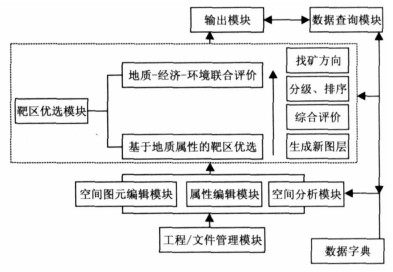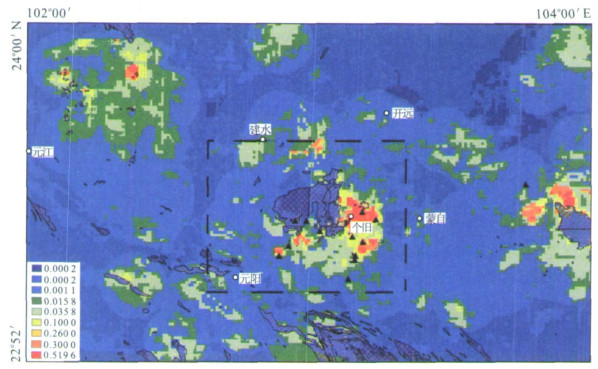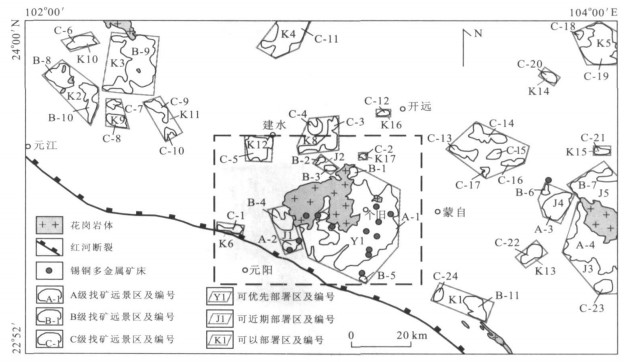GIS Technique of Optimum Target Areas in Mineral Resource Prospecting
-
摘要:
靶区优选是矿产勘查中的一个关键环节, 它既是矿产资源预测成果的直接体现形式, 同时又是联系矿产资源预测与勘查工作部署的桥梁.然而, 由于人们认识上的不完备性和缺乏相应的技术手段支撑, 使得靶区优选常被忽视或简化.探讨了靶区优选的地质基础原则, 建立了靶区优选的技术流程, 研发了基于GIS支持下靶区优选计算机辅助决策模块, 并以云南省个旧地区与岩浆活动有关的锡铜多金属矿靶区为例进行了示范研究.结果表明靶区优选技术及相应的软件能够客观地反映不同靶区的特征, 提高靶区优选的智能化程度和工作效率.
Abstract:Optimum target area (OTA) plays an important rule in mineral resource prospecting, which is not only the end production of mineral resource assessment, but also the bridge between the mineral resource assessment and exploration plan.However, it is usually ignored or simplified owing to the incomplete cognition and being lack of technique or software.In this paper, we disscuss the OTA principles based on the geology, set up the data flow for OTA and develop the GIS-based OTA model.The Gejiu, Yunnan, southwestern China, was chosen as an example to do the demonstration research.The results demonstrate that the OTA model could reflect the properties of target areas, and can enhance the efficiency of OTA.
-
表 1 个旧地区矿产预测概念模型
Table 1. Concept model of mineral resource assessment in Gejiu, China

表 2 个旧地区找矿有利地段
Table 2. Schedule of preferable ore-finding areas in Gejiu, China

表 3 “地质-经济-环境”联合评价指标体系
Table 3. Index system of the united evaluation for geology-economy-environment

-
Bardossy, G., Fodor, J., 2004. Evaluation of uncertaintiesand risks in geology. Springer, Berlin. Bonham-Carter, G. F., 1994. Geographic information systemsfor geoscientists: Modelling with GIS. Pergamon, Oxford, 398. Cheng, Q. M., 2007. Mapping singularities with streamsediment geochemical data for prediction of undiscoveredmineral deposits in Gejiu, Yunnan Province, China. OreGeology Reviews, 32 (1-2): 314-324. https://www.sciencedirect.com/science/article/abs/pii/S0169136806001119 Cheng, Q. M., 2008. Singularity of mineralization and multifractal distribution of mineral deposits. Bulletin of Mineralogy, Petrology and Geochemistry, 27 (3): 298-305 (in Chinese with English abstract). https://oversea.cnki.net/kcms/detail/detail.aspx?dbcode=CJFD&dbname=CJFD2008&filename=KYDH200803014 Cheng, Q. M., Agterberg, F. P., 2008. Singularity analysis of ore-mineral and toxic trace elements in stream sediments. Computers & Geosciences, DOI: 10.1016/j.ca-geo.2008.02.034. Cheng, Q. M., Zhao, P. D., Chen, J. G., et al., 2009a. Application of singularity theory in prediction of tin and copper mineral deposits in Gejiu district, Yunnan, China: Weak information extraction and mixing information decomposition. Earth Science-Journal of China University of Geosciences, 34 (2): 232-242 (in Chinese with English abstract). doi: 10.3799/dqkx.2009.021 Cheng, Q. M., Zhao, P. D., Zhang, S. Y., et al., 2009b. Application of singularity theory in prediction of tin and copper mineral deposits in Gejiu district, Yunnan, China: Information integration and delineation of mineral exploration targets. Earth Science-Journal of China University of Geosciences, 34 (2): 243-252 (in Chinese with English abstract). doi: 10.3799/dqkx.2009.022 Li, Z. L., 1994. Application of multi-factors fuzzy assessment method in optimum target areas. Geological Science and Technology of Jiangxi, 21 (4): 47-50 (in Chinese). Lu, Y., Li, S. L., Yu, C. J., et al., 1996. Application of geological anomalies theory to the preference and evaluation of ore-search target. Geology and Prospecting, 32 (1): 7-12 (in Chinese with English abstract). U. S. Department of the Interior, U. S. Geological Survey, 2005. The U. S. geological survey mineral resources program five-year plan, 2006-2010. http://minerals.usgs.gov/plan/2006-2010/2006-2010-plan.html. Wang, G. W., Du, Y. S., 2000. Synthetical research of multiinformation of metallogeny and optimization of prospecting targets in Yulong copper ore belt. Geoscience, 14 (2): 158-164 (in Chinese with English abstract). https://en.cnki.com.cn/Article_en/CJFDTOTAL-XDDZ200002008.htm Xia, Q. L., 2008. Theories and methods of optimum targetareas in mineral resources exploration. In: Chen, Y. C., Xue, C. J., Zhang, C. Q., eds., Explortion of the depth, development of the west, outlook of the world: The Proceeding of the 9th National Conference of Mineral Deposits, China. Geological Publishing House, Beijing, 737-738 (in Chinese). Xia, Q. L., Zhang, S. T., Chen, S. Y., et al., 2007. The keyproblems for deep mineral potential assessment in Gejiutin deposit, Yunnan, China. Acta Mineralogica Sinica, 27 (Suppl. ): 530-531 (in Chinese). Zhang, S. T., Xia, Q. L., Zhao, P. D., et al., 2008. Diversity of mineralization and spectrum of the Gejiu superlargetin-copper polymetallic deposit, Yunnan, China. Journal of China University of Geosciences, 19 (4): 363-370. doi: 10.1016/S1002-0705(08)60069-2 Zhao, P. D., Cheng, Q. M., Xia, Q. L., 2008. Quantitative prediction for deep mineral exploration. Journal of China University of Geosciences, 19 (4): 309-318. doi: 10.1016/S1002-0705(08)60063-1 Zhao, P.D., Chi, S.D., Li, Z.D., et al., 2001. Theo ries and methods for mineral exploration. China Univer sity of Geosciences Press, Wuhan (in Chinese). Zhou, Z. Y., Cheng, F. D., 1995. The application of the fuzzy direct recognition method to ore prognosis in southern Hunan. Geophysical & Geochemical Exploration, 19 (4): 271-279 (in Chinese with English abstract). http://www.wutanyuhuatan.com/EN/abstract/abstract3515.shtml Zuo, R. G., Xia, Q. L., 2008. The uncertainty propagation model in mineral resources predication. Progress in Geophysics, 23 (4): 1282-1285 (in Chinese with English abstract). http://www.progeophys.cn/EN/Y2008/V23/I4/1282 Zuo, R. G., Xia, Q. L., Tan, N., et al., 2007. Synthetic information prediction of porphyry copper in Tibet. Journalof Central South University (Science and Technology), 38 (2): 368-373 (in Chinese with English abstract). 成秋明, 2008. 成矿过程奇异性与矿床多重分形分布. 矿物岩石地球化学通报, 27 (3): 298-305. doi: 10.3969/j.issn.1007-2802.2008.03.012 成秋明, 赵鹏大, 陈建国, 等, 2009a. 奇异性理论在个旧锡铜矿产资源预测中的应用: 成矿弱信息提取和复合信息分解. 地球科学——中国地质大学学报, 34 (2): 232-242. https://www.cnki.com.cn/Article/CJFDTOTAL-DQKX200902001.htm 成秋明, 赵鹏大, 张生元, 等, 2009b. 奇异性理论在个旧锡铜矿产资源预测中的应用: 综合信息集成与靶区圈定. 地球科学——中国地质大学学报, 34 (2): 243-252. https://www.cnki.com.cn/Article/CJFDTOTAL-DQKX200902002.htm 李中兰, 1994. 多因子模糊综合评估法在找矿靶区优选中的应用. 江西地质科技, 21 (4): 47-50. https://www.cnki.com.cn/Article/CJFDTOTAL-JXZK199404011.htm 卢宇, 李师兰, 余成就, 等, 1996. 地质异常理论在找矿靶区优选与评价中的应用. 地质与勘探, 32 (1): 7-12. https://www.cnki.com.cn/Article/CJFDTOTAL-DZKT601.001.htm 王功文, 杜杨松, 2000. 玉龙铜矿带成矿多元信息综合分析与找矿靶区优选. 现代地质, 14 (2): 158-164. doi: 10.3969/j.issn.1000-8527.2000.02.007 夏庆霖, 2008. 矿产勘查靶区优选理论与方法. 见: 陈毓川, 薛春纪, 张长青, 主编. 主攻深部, 挺进西部, 放眼世界——第九届全国矿床会议论文集. 北京: 地质出版社, 737-738. 夏庆霖, 张寿庭, 陈守余, 等, 2007. 云南个旧锡矿深部资源潜力评价的几个关键问题. 矿物学报, 27 (增刊): 530-531. https://ccd1.cqvip.com/Qikan/Article/Detail?id=1000105777 赵鹏大, 池顺都, 李志德, 等, 2001. 矿产勘查理论与方法. 武汉: 中国地质大学出版社. 周子勇, 程方道, 1995. 模糊直接识别方法在湘南地区成矿预测中的应用. 物探与化探, 19 (4): 271-279. https://www.cnki.com.cn/Article/CJFDTOTAL-WTYH504.003.htm 左仁广, 夏庆霖, 2008. 矿产预测中的不确定性传播模型. 地球物理学进展, 23 (4): 1282-1285. https://www.cnki.com.cn/Article/CJFDTOTAL-DQWJ200804041.htm 左仁广, 夏庆霖, 谭宁, 等, 2007. 西藏冈底斯斑岩铜矿综合信息预测. 中南大学学报(自然科学版), 38 (2): 368-373. doi: 10.3969/j.issn.1672-7207.2007.02.034 -










 下载:
下载:



